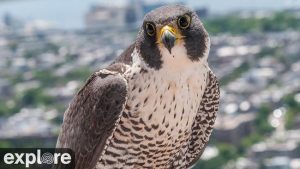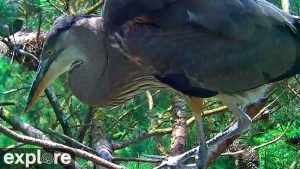Peregrine Eyas hatchlings
 Chesapeake Conservancy nest cams get new stars in Great Blue Heron, Peregrine Eyas hatchlings
Chesapeake Conservancy nest cams get new stars in Great Blue Heron, Peregrine Eyas hatchlings
Selene San Felice From Capital Gazette
In the hottest reality TV news since Khloe Kardashian gave birth earlier this month, the Chesapeake Bay Conservancy’s nest cams have a few new baby cast members of their own.
The first baby blue herons of the season arrived for parents Rell and Eddie, hatching all four of their eggs over the weekend. Not to be outdone, peregrine falcon mama Barb began hatching her first eyasses of the season just a few minutes after the first heron hatch. Barb now has three babies and one egg with her partner, Boh.
The conservancy calls its great blue heron, peregrine falcon and osprey nest cams better entertainment than “The Bachelor” or the Kardashians, proudly citing 10 million viewers from around the world in 2017, including countries like Iceland, Ghana, the Cayman Islands, Armenia, China, and Belize.
“The cams are a fascinating and addicting way to observe the wonders of nature,” communications director Jody Couser said.
Welcome to a Maryland rookery of one of Chesapeake’s most iconic birds: the great blue heron. Watch live and learn more about these fascinating waders on Explore.org @ https://goo. …
The great blue heron cam on the Eastern Shore is the newest of the conservancy’s nest cams, starting in 2016. Now in its third season, the herons received an updated camera from Explore.org showing three of the rookery’s 10 to 12 nests. The rookery supports up to 50 heron once all of the season’s eggs have hatched.
The cam was launched with funds generated through a crowdfunding campaign and help from Waterfowl Chesapeake. The stars, Rell and Eddie are named after surfers Rell Sunn and Eddie Aikau.
They live 100 feet above the ground in loblolly pine trees, where viewers have watched the birds mate, incubate and care for their babies. Two other nests in the rookery have brooding mamas, but the conservancy said it’s not sure how many eggs they have.
Great blue herons select new mates every year. Each bird lays between two and seven eggs, which incubate around 28 days until hatching. The baby birds are fed for around 60 days in the nest by both parents.
This peregrine falcon family makes its home in an unlikely place: a skyscraper in downtown Baltimore. Watch live and learn more about these adaptable birds of prey on Explore.org @ …
Barb and Boh have been the stars of the peregrine falcon cam since 2015 in their nest on the 33rd floor of the Transamerica Building in downtown Baltimore. The falcons are named in honor of former Sen. Barbara Mikulski and “Natty Boh” beer.
The falcons are descendants of peregrines released by The Peregrine Fund in the 1970s when the peregrine and osprey faced near eradication due to the effects of DDT. Those birds first made their home on the same ledge. Peregrines naturally like to nest on the side of cliffs, and incubate their eggs in indentations in sand or gravel.
Peregrine usually migrate, but Boh & Barb are happy with the abundance of food sources their Baltimore nest provides.
“Barb does most of the incubating but Boh does allow her some breaks,” Couser said.
Set with a view of the Baltimore Skyline, nest cam-watchers can see Boh and Barb bring back food for the new babies from their hunts, observe the eyasses growing and preparing to fledge, and maybe even catch the moment the last egg may hatch.
Couser notes that the survival rate for peregrines is 50 percent their first few years.
“The cam is a unique way to watch these beautiful birds of prey in their home, but of course that is not always easy for humans to watch,” she said.
All three nest cams can be viewed at www.chesapeakeconservancy.org/explore/wildlife-webcams
IMAGES:
Screenshots
The Chesapeake Conservancy and Explore.org operate a wildlife webcam featuring three great blue heron nests on Maryland’s Eastern Shore. Visit www.chesapeakeconservancy.org to watch live day or night. There is a bouncing baby blue heron with three other eggs yet to hatch in its nest.
For more on this story and video go to: http://www.capitalgazette.com/news/environment/ac-cn-nest-cam-hatch-0430-story.html







